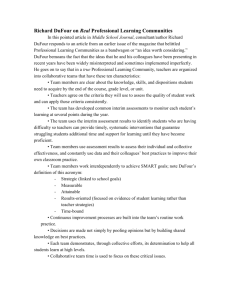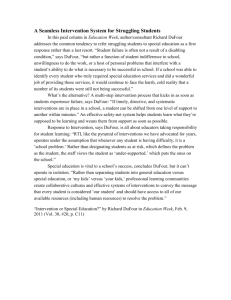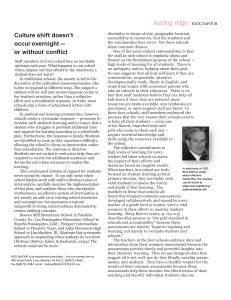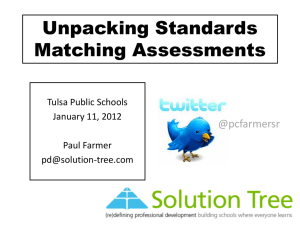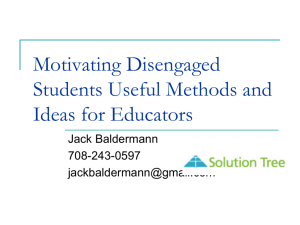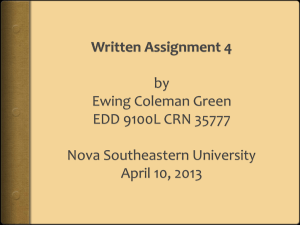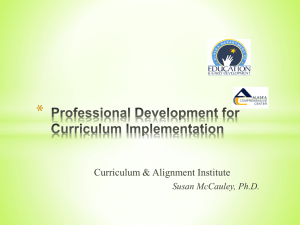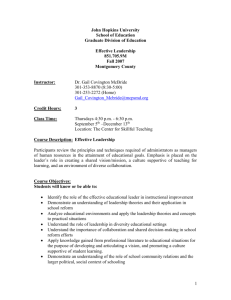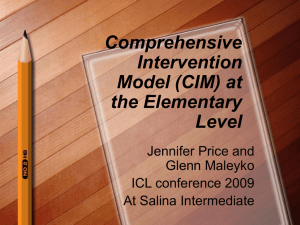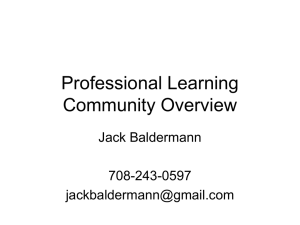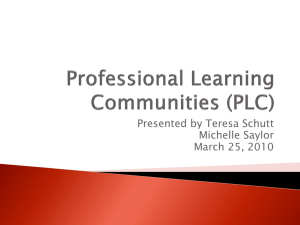School Improvement
advertisement
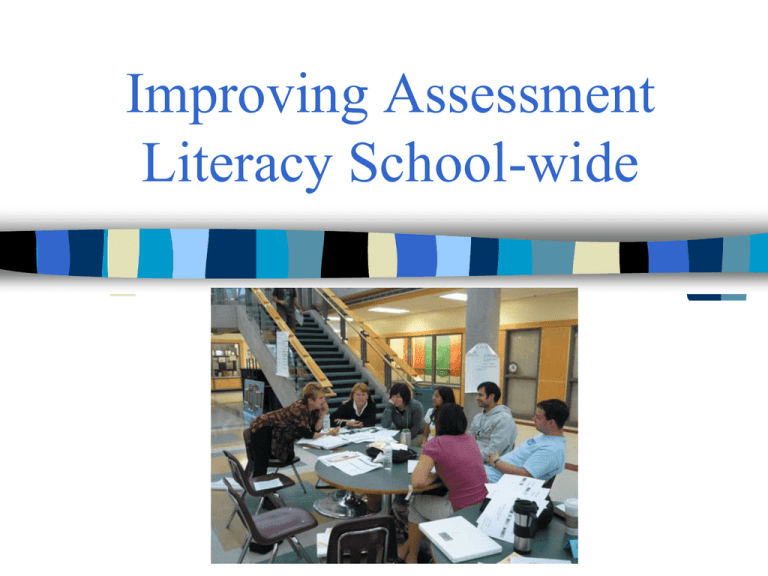
Improving Assessment Literacy School-wide School and System Improvement Improvement by Contract -external threats and rewards Improvement by Culture -partnerships, collaboration, teamwork, community Caring is as important as learning Hargreaves, 2003 School and System Improvement Professional learning communities use evidence and intuition in order to work and talk together to review their practices and to increase their success…In a professional learning community, the culture changes – everyone sees the big picture and works for the good of the whole community. Professional learning communities bring together culture and contract. They value both excellence and enjoyment. Hargreaves, 2004 The Big Ideas of Professional Learning Communities Ensuring that students learn A Culture of Collaboration A Focus on Results DuFour, 2004 The Big Ideas of Professional Learning Communities Ensuring that students learn: -Focus on learning -What do we want each student to learn? -How will we know when each student has learned it? -How will we respond when a student experiences difficulty in learning? DuFour, 2004 The Big Ideas of Professional Learning Communities A Culture of Collaboration -partnerships -sharing knowledge and learning -team work -community -conversations DuFour, 2004 The Big Ideas of Professional Learning Communities A Focus on Results -establish baseline data -set improvement goals -work together to achieve goals -gather frequent evidence of progress -identify strategies that lead to the greatest gains -share these with colleagues DuFour, 2004 Teacher Learning: What Matters (Linda Darling-Hammond, 2009) Centred on student learning Integrated with school improvement Active, sustained learning Principal Leadership (DuFour and Marzano, 2009) Create schedules so teams meet at least one hour per week Create collaborative structures for teams to focus on issues that directly affect student learning Provide teams with training, support, and resources to implement new approaches Monitor progress through tangible products and dialogue Time to Talk Discuss the comments from Hargreaves, DuFour, DarlingHammond, and Marzano To what extent does your school`s current approach to improvement reflect their recommendations? Which of their recommendations require your attention? School Improvement through Assessment Reform A Vision is Essential! “Attaining any vision of assessment excellence requires that certain conditions be in place. Those conditions include well-defined learning targets for students, supportive school and district policies, clear communication systems, and most important, assessment-literate teachers and administrators.” Rick Stiggins Improving Assessment Literacy: Essential Elements - Cooper Clear mission and vision Alignment of curriculum, assessment, and communication systems Clear and coherent curriculum map, K-12 High-quality, “backward-designed” units High-quality assessments and tools Improving Assessment Literacy: Essential Elements - Cooper Assessment and grading policy to guide and support practice School-wide assessment literacy Students empowered to self and peer assess and to act as instructional support for each other Well-informed parents who support initiatives Ongoing process to monitor project Dare to Dream! It’s June, 2012. You are conducting a Walkabout on your campus. Use your creativity to communicate to your colleagues what you see and hear during your Walkabout. Reality Check! What are the major obstacles to realizing this vision in your school? To realize our vision, we need a plan ... Designing Down from the Desired State Goal Area: e.g. Grading and Reporting 1. 2. 3. 4. 5. 6. 7. What specifically needs to be done? How does it need to be done? What is the timeline for doing it? Who is responsible for getting it done? What resources are needed? How will we monitor progress? How often and by what means will we communicate progress? 8. How will we celebrate success? Desired State Actions Key Result Areas Grading policy Grading software Report card design Goal Area: e.g. Grading and Reporting Current State Improvement Planning Template Desired State/Goal: Current State, including Evidence Indicators of Desired State (may include targets) Specific Measures (tools used to gather data) Strategies (specific actions that will be taken) Resources (improvement teams, materials) Lead Responsibility Timelines Communicating Progress Celebration of Success Four Conditions for Sustainable Improvement Focus Pressure and support Collaboration Stay the course The Big Ideas of Classroom Assessment 1. Assessment serves different purposes at different times: it may be used to find out what students already know and can do; it may be used to help students improve their learning; or it may be used to let students, and their parents, know how much they have learned within a prescribed period of time. 2. Assessment must be planned and purposeful. 3. Assessment must be balanced, including oral and performance as well as written tasks, and be flexible in order to improve learning for all students. The Big Ideas of Classroom Assessment 4. Assessment and instruction are inseparable because effective assessment informs learning. 5. For assessment to be helpful to students, it must inform them in words, not numerical scores or letter grades, what they have done well, what they have done poorly, and what they need to do next in order to improve. 6. Assessment is a collaborative process that is most effective when it involves self, peer, and teacher assessment. The Big Ideas of Classroom Assessment 7. Performance standards are an essential component of effective assessment. 8. Grading and reporting student achievement is a caring, sensitive process that requires teachers’ professional judgement. Four Conditions: Focus Identify areas of greatest need -human bar graph -survey data -observation School-wide focus Embed within other initiatives Case Study: Walkden High School 3-Year Assessment for Learning Project Year 1: focus on specific, descriptive oral and written feedback to students Year 2: strategies for self and peer assessment Year 3: Lesson Design Time to Talk about Focus How focussed is our school’s improvement plan? Do we need to sharpen the focus to improve our plan? Time to Talk about Focus What sources of data are identifying our focus for improvement? Are these data sufficient? If not, what further data do we need to gather? Pressure & Support: Walkden High School Head and Assistant both teach a class 8 AFL Key Teachers who work across departments to model and coach best practice They have half day per week outside of school to do research Every committee and meeting must have an AFL component Four Conditions: Pressure ... Teachers submit tangible evidence of their collaborative work e.g. Units of study, common assessments, etc. Annual improvement plans for all teachers include the initiative Struggling teachers teamed with those who have mastered the desired skills Time to Talk about Pressure How are teachers held accountable for improving their practice? How do we move from “pockets of improvement” to a critical mass? Four Conditions: ... and Support Common resources to communicate best practice, etc. (print resources, handbook, on-line resources, etc.) PD events to communicate the message Key teachers to lead the charge and provide training Time to Talk about Support What professional learning resources are available to leaders and teachers to inform this improvement initiative? What professional learning opportunities are available to teachers during this project? Four Conditions: Collaboration Within grade or course teams (unit design) Between grade or course teams (program design) System-wide: e.g. efficient use of technology to create banks of units, assessments, tools, etc. Coaching and mentoring within grade or course teams Key Teachers provide training across the school Unit Planning Time to Talk about Collaboration What collaborative structures exist in our school that facilitate improvement? Are these structures sufficient? If not, what needs to change? Time to Talk about Collaboration Is peer coaching part of our improvement initiative? If not, could it be? If it is, how well is it working? How might it be improved or expanded? What PLC or similar approach is being used to facilitate our improvement initiative? Four Conditions: Staying the Course Minimum 3-Year, ``design down`` from desired state plan Frequent monitoring of progress Adjust plan according to data Integrate with other initiatives as they occur Celebrate success as it occurs Plan for sustainability Time to Talk about Staying the Course How are we monitoring our improvement initiative: - teacher self-monitoring? (e.g. reflective journals) - teacher peer-monitoring? - administrative monitoring? Some final thoughts... “Change is a process, not an event… beware the implementation dip.” (Fullan) Teachers must not work alone. Collaboration will help them problem solve and will improve the quality of your school’s initiatives. Be proactive - communicate with parents and students before changing practices and procedures. Commitment to Action Spend a few moments reflecting on your learning today…. What was your most significant learning? What specific actions do you plan to take immediately and/or between now and June 2010? Who will be involved? What results would you like to see from these actions? How will you assess the effectiveness of these actions? 42 School Improvement Bibliography Cooper, Damian. Talk About Assessment: High School Strategies and Tools, Nelson Education, 2010. ISBN-10: 0-17-635712-2 Darling-Hammond, L. & Richardson, N. Teacher Learning: What Matters, Educational Leadership, February 2009, 46-53 DuFour, R. &Marzano, R. J. High Leverage Strategies for Principal Leadership, Educational Leadership, February 2009, 62-68 DuFour, R., R. Eaker, R. DuFour, and G. Karhanek. 2004. Whatever it Takes: How Professional Learning Communities Respond When Kids Don't Learn, Solution Tree, Bloomington, IN. Guskey, Thomas R. Evaluating Professional Development, Corwin Press, 2000, ISBN 0-7619-7561-6 Hargreaves, Andy. Teaching in the Knowledge Society: Education in the Age of Insecurity, Teachers College Press, 2003. ISBN. 0-8077-4360-7
